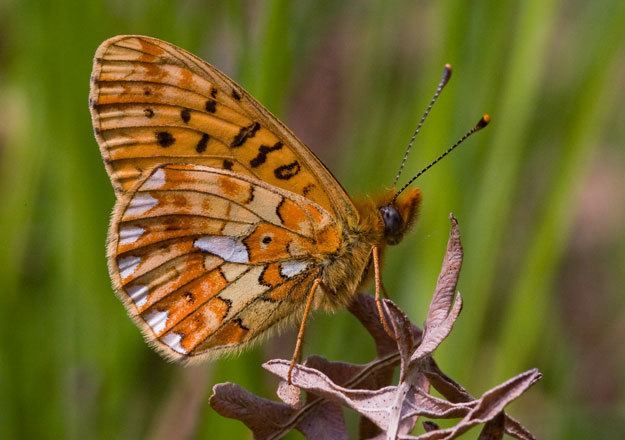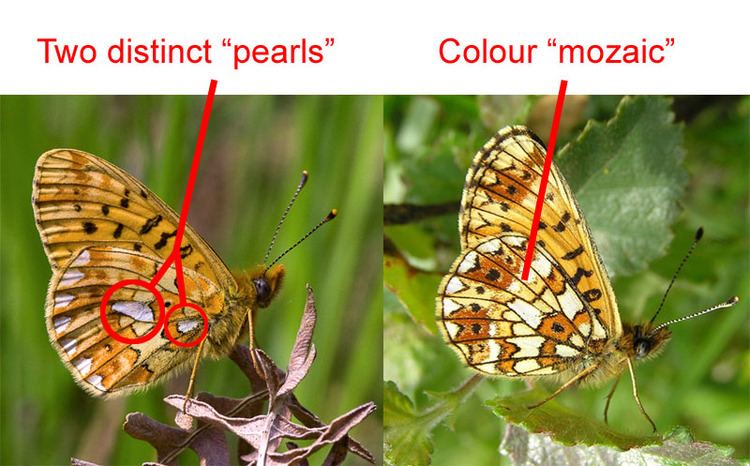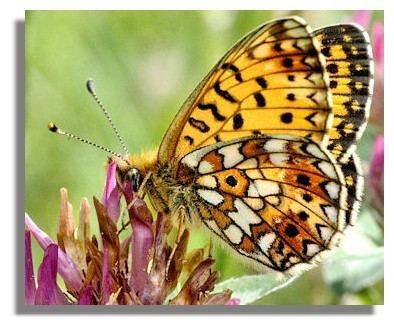Higher classification Boloria | Scientific name Boloria euphrosyne Rank Species | |
 | ||
Similar Boloria, Butterfly, Heath fritillary, High brown fritillary, Dark green fritillary | ||
Pearl bordered fritillary
The pearl-bordered fritillary (Boloria euphrosyne) is a butterfly of the Nymphalidae family found in Europe and northern Asia.
Contents
- Pearl bordered fritillary
- Description
- Distribution
- Subspecies
- Food plants and eggs
- Caterpillar pupa and adult
- Habitat
- Management
- Example sites where found
- References
Pearl bordered fritillary
Description

It is orange with black spots on the upperside of its wing and has a wingspan of 38–46 mm. On the underside of the wings there is a row of silver-pearly markings along the edge, which give the species its name. It is often confused with the small pearl-bordered fritillary, but can be distinguished from it by the triangle along its pearl border (the small pearl-bordered has black chevrons) as well as the presence of a single silver spot in the middle of a row of yellow spots. The female has both darker markings and rounder wings than the male. The caterpillars are black with white or yellow spines along their backs.

Like other species of fritillary, the males have special scent glands on their wings so that they can be recognised by females of their own species and therefore find a suitable partner.
Distribution

The pearl-bordered fritillary is widespread throughout Europe, ranging from Scandinavia to northern Spain and from Ireland eastwards towards Russia and Asia. In England and Wales (plus another 10 countries) it has declined rapidly in number and is a highly threatened species - nbn gateway distribution map.
Subspecies

Food plants and eggs

After mating, the female will lay her eggs on dead bracken (Pteridium aquilinum), or leaf litter near to violet plants – common dog–violet (Viola riviniana), heath dog–violet (Viola canina) or marsh violet (Viola palustris). Sometimes they are laid on the leaves of the food plant itself. They are laid singly, not in one large group such as the marsh fritillary. The mosaics that they prefer are typically one–third grass and two–thirds bracken.

Eggs can be found on the food plant from mid–May to the end of June. They are a pale yellow and can hatch after 10–14 days.
Caterpillar, pupa, and adult
The emerging caterpillars begin feeding immediately and will moult three times within the first 5–6 weeks. Each caterpillar will then hibernate in a shrivelled leaf at the base of the plant, usually at the end of July. When they awaken the following March, they are half their previous size having shrunk during hibernation. After a period of feeding and growth, during which it moults one last time, the caterpillar is full size and ready to pupate. The chrysalis stage is formed amongst the leaf litter, and lasts just 10–14 days.
The adult butterfly flies between late April and June, being one of the earliest fritillaries to emerge. It will feed on the nectar from early spring flowers such as bugle, dandelion (Taraxacum officinale), and lesser celandine.
There is a second brood during August.
